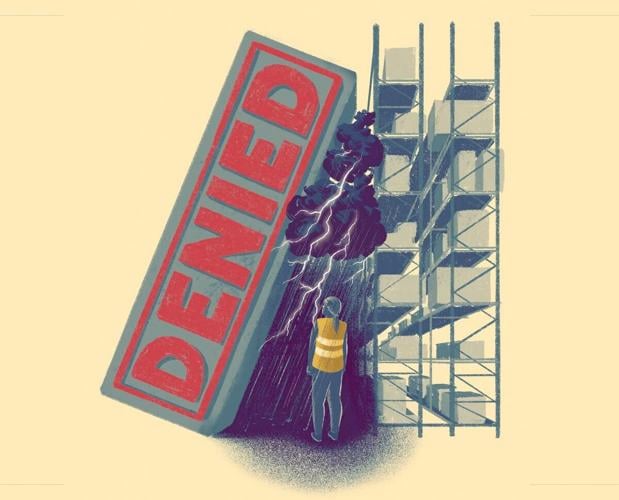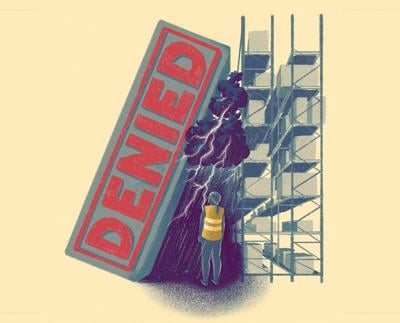It was a Saturday in September when a school custodian witnessed something horrifying.
She was attending an after-hours union meeting when she happened to glance over at a colleague. His cellphone was out and he was busy showing something to a friend: child pornography.
Appalled, the custodian formally reported the incident to her superiors. What followed was an onslaught of vile abuse, both at work and home, in which she was ŌĆ£harassed, threatened and stalkedŌĆØ by her male colleague. The situation became so dire that the courts issued a protection order to keep her safe.
But when she sought compensation from the Workplace Safety and Insurance Board for chronic mental stress, her claim was denied. It took nearly three years of appeals for the worker to be granted benefits, after an independent tribunal finally ruled the WSIBŌĆÖs decision was wrong, and workplace harassment had indeed caused her diagnosed mental health condition.
Claims like the school custodianŌĆÖs were made possible by a significant piece of reform in 2018 ŌĆö rectifying decades of exclusion for workers who experienced excessive, long-term stress on the job.
Workers had long been eligible for compensation for sudden, traumatic events, such as witnessing a horrific accident. But the new reforms allowed them to file claims for a different type of stressor: chronic workplace harassment, abuse and extreme pressure.
The shift was a landmark victory that advocates hoped would reflect a growing body of empirical evidence: just as work can sometimes result in physical injuries, so too can it also damage our mental health.
Over the past five years, however, new data shows the board has systematically denied thousands of these claims ŌĆö at rates that far exceed other kinds of workplace injuries.
Far from providing a safety net to vulnerable workers, the boardŌĆÖs approach to chronic stress has turned into a ŌĆ£get-out-of-compensation-free card for both the WSIB and employers,ŌĆØ said Chris Grawey of Injured WorkersŌĆÖ Consultants (IWC), a non-profit community legal clinic.
WSIB denies most chronic stress claimants
Overall, the WSIB accepts more than three quarters of injury claims made by Ontario workers, according to board data.
The picture is inverted when it comes to chronic mental stress claims: the board has routinely denied more than 90 per cent of applicants, the data shows.
ŌĆ£That is a significant difference,ŌĆØ said Grawey. ŌĆ£ItŌĆÖs not even close.ŌĆØ

Chris Grawey is a paralegal Injured Workers’ Consultants (IWC), a non-profit community legal clinic.
║ŻĮŪ╔ńŪ°╣┘═°StarThe school custodian is among a small number of people who challenged the WSIBŌĆÖs denial of their chronic stress claim all the way to the provincial worker compensation tribunal. Tribunal decisions do not name the workers who appeal.
In a statement, WSIB spokesperson Christine Arnott called mental health a ŌĆ£very important aspect of health and wellness.ŌĆØ
ŌĆ£We are one of only five Canadian provinces or territories to offer coverage for chronic mental stress injuries stemming from work, like bullying or harassment.ŌĆØ
The boardŌĆÖs goal, said Arnott, is to ŌĆ£move quickly to get people the benefits, services and support they needŌĆØ within the eligibility rules set out in law.
ŌĆ£That can be challenging and complex with mental stress injuries,ŌĆØ she said.
ŌĆ£Our experience has been that the vast majority of claims submitted do not meet the eligibility criteria.ŌĆØ
Critics call the criteria discriminatory and overly restrictive.
ŌĆ£IŌĆÖm expecting that at some point, somebodyŌĆÖs going to challenge the constitutionality of the policy,ŌĆØ said Michelle Zare, who runs a Hamilton-based paralegal firm specializing in workersŌĆÖ compensation and particularly chronic stress.
Legal experts, as well as the independent workersŌĆÖ compensation tribunal, have long held that employees with mental stress injuries are entitled to the same treatment under the law as those with physical injuries.
But the WSIB subjects chronic stress claims to a stricter legal test than all other kinds of injuries, a feature that was introduced after employer lobbying, documents obtained by the Star reveal.
Critics now believe the boardŌĆÖs policy, which was intended to correct the unconstitutional exclusion of mentally ill workers from benefits, in fact entrenches discrimination against them.
ŌĆ£They replaced a discriminatory law with a discriminatory policy,ŌĆØ said Grawey.
Business groups lobbied for stricter legal test
Of the 7,300 Ontario workers who filed for chronic stress benefits since 2017, fewer than 600 have been successful. That is around eight per cent, according to the WSIBŌĆÖs data obtained by the IWC and shared with the Star.
ItŌĆÖs a significantly lower acceptance rate than for traumatic mental stress claims, which are the closest equivalent injury.
While 2022 was one of the most successful years to date for chronic stress claims ŌĆö 12 per cent were accepted ŌĆö in some years as little as five per cent of claimants were awarded compensation.
To get compensation for an injury, workers generally have to demonstrate that their job was a significant contributing factor ŌĆö but not necessarily the main factor.
That is the legal test the WSIB had originally contemplated applying to chronic mental stress injuries, according to a draft version of its policy obtained by the Star, dated May 4, 2017.
The proposal, however, prompted a wave of outcry from employer groups. In a series of submissions made to the board that summer, some of the provinceŌĆÖs largest employers and lobby groups claimed the draft policy would invite a ŌĆ£floodŌĆØ of claims and impose significant new costs on businesses.
These groups demanded a different approach, one that would require claimants to show the workplace was the ŌĆ£predominant causeŌĆØ of their chronic stress injury.
That is a significantly higher bar than the one required of workers with all other types of injuries.
The difference was justified because mental injuries werenŌĆÖt like physical ones, employers argued. Mental stress was more complex and ŌĆ£multi-factorial,ŌĆØ employers said, echoing a finding made in the 1999 British Columbia Royal Commission on WorkersŌĆÖ Compensation. Several other compensation boards with chronic stress policies had already adopted the stricter legal test, including Alberta, which introduced a chronic stress policy in 2000.
By the time the WSIB was considering its own approach, the Royal Commission report was almost two decades old. Its findings had also been debunked by OntarioŌĆÖs own compensation tribunal, notes Maryth Yachnin, a lawyer with Industrial Accident VictimsŌĆÖ Group of Ontario (IAVGO).
The tribunal had found that physical and mental injuries are not substantially different and should not be treated as such. Both can be complicated and both can have multiple causes, the tribunal noted: the boardŌĆÖs job in both scenarios is to follow the evidence and arrive at a fair decision.
Despite opposition from labour advocates, the WSIB adopted the predominant cause test.
ŌĆ£It stems from old fashioned and discriminatory attitudes toward mental health,ŌĆØ said Yachnin.
ŌĆ£ItŌĆÖs the idea that mental health injuries are essentially too hard to understand or that the things that caused them are unable to be identified. ItŌĆÖs just not true.ŌĆØ
Why the WSIB says claims were denied
While the WSIB says it has engaged with advocates about work-related stress, it calls criticsŌĆÖ focus on the predominant cause test ŌĆ£misplaced.ŌĆØ
The board says the stricter legal standard has ŌĆ£little to no impactŌĆØ on the eligibility of most claims it receives, and says most claims are denied for other reasons.
Workers can only make chronic stress claims under specific circumstances. They cannot make claims for stress caused by ŌĆ£employmentŌĆØ related decisions, including changes in productivity requirements, scheduling, disciplinary action or demotions. Workers also cannot make stress claims for ŌĆ£interpersonal conflict.ŌĆØ
Those exclusions are set out in provincial legislation guiding the WSIB, and account for 63 per cent of denied chronic stress claims, Arnott said.

The Workplace Safety Insurance Board has denied more than 90 per cent of claims filed for chronic mental stress, a rate that far exceeds other kinds of workplace injuries.
THE CANADIAN PRESSWorkers must also prove the stressors they experience are ŌĆ£substantialŌĆØ and more intense than ŌĆ£general pressuresŌĆØ on the job. A further 37 per cent of denied claims were ineligible because workers could not meet that bar, said Arnott.
Critics take issue with these exclusions, too. Problems like workload and burnout can have very real consequences for mental health, said Zare. Meanwhile, workers with physical injuries donŌĆÖt need to show the stressors they experienced on the job were more excessive than those faced by other employees, said Grawey.
In response to questions from the Star about possible reform to address those concerns, the labour ministryŌĆÖs acting press secretary Sydney Dubin said the provincial workersŌĆÖ compensation system needed to ŌĆ£improve.ŌĆØ
ŌĆ£That is why our government launched a review of the WSIB and installed new leadership at the agency last year. Over the coming months, we will continue to make changes that put injured workers and their families first.ŌĆØ
What constitutes ŌĆśexcessiveŌĆÖ workplace stress?
In the meantime, defining what constitutes ŌĆ£excessiveŌĆØ workplace stress is fraught.
Over the past two years, around 87 chronic stress appeals have reached the provincial workersŌĆÖ compensation tribunal, according to the data obtained by IWC. In at least 15 of these cases, the tribunal overturned the boardŌĆÖs decisions, highlighting sometimes egregious workplace abuse that the WSIB had said wasnŌĆÖt eligible for compensation.
In one such case, a worker filed a chronic mental stress claim after her male colleague began surreptitiously surveilling her, creating a computer log with as many as 20 entries a day documenting everything from her arrival times to when she went to the washroom. The worker, who was a business manager for a police force, was subsequently diagnosed with a general anxiety disorder.
But the WSIB ruled that she was not entitled to benefits because while her colleagueŌĆÖs behaviour was ŌĆ£not acceptable,ŌĆØ it did not constitute ŌĆ£abusive conduct.ŌĆØ The tribunal slapped down the boardŌĆÖs decision, noting that a man obsessively surveilling a woman at work is ŌĆ£conduct that a reasonable person would find both egregious and vexatious.ŌĆØ
In another ruling reviewed by the Star, a warehouse worker with a hearing impairment was told by the WSIB that taunting, harassment and discrimination on the job, including being labelled a ŌĆ£Deaf f ŌĆö kŌĆØ by a colleague, did not amount to a ŌĆ£substantialŌĆØ workplace stressor.
In another case, a personal support worker subjected to unwanted touching, sexualized comments and ŌĆ£explosiveŌĆØ outbursts on the job was told her chronic stress claim did not meet board ŌĆ£requirements.ŌĆØ
In all of these cases, the tribunal overturned the WSIBŌĆÖs decisions to deny workersŌĆÖ benefits.
The 15 WSIB decisions that have been overturned by the tribunal account for just 0.2 per cent of the 7,300 decisions made by the board, Arnott said.
ŌĆ£(That) does indicate our decision-making system is working well within the rules established by the legislation and policy,ŌĆØ she said, adding that people often present ŌĆ£new information or evidenceŌĆØ that can result in a ruling to overturn the boardŌĆÖs original decision.
The problem, said Zare, is that most workers choose not to challenge the boardŌĆÖs decisions because the process is onerous. After internal appeals are exhausted, it takes, on average, over a year to get a tribunal hearing and decision issued, forcing workers to relive traumatic experiences and sometimes incur a mountain of legal fees.
ŌĆ£During that entire time, how do you even begin to deal with your mental health and your trauma, if you donŌĆÖt have access to health care?ŌĆØ said Zare.
Workers making stress claims often already work in precarious jobs where toxic environments are more common, said Yachnin. But without compensation, seeking treatment can be difficult given the lack of publicly funded resources.
Instead, many end up on social programs like Ontario Works, said Grawey.
ŌĆ£That puts many workers in a more precarious financial situation, and often, in poverty.ŌĆØ
While a steady stream of Ontario workers have applied for chronic stress benefits, the overall number of claimants is small and on par with smaller provinces like Alberta, data obtained by the Star shows. The ŌĆ£floodŌĆØ of stress claims employers once predicted has yet to materialize.





























